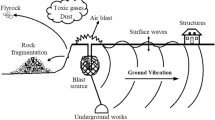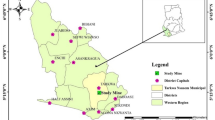Abstract
This paper deals with the application of a support vector machine (SVM) optimization technique to predict the blast-induced ground vibration. Peak particle velocity (PPV) is an important parameter to be kept under control to minimize the damage caused due to the ground vibration. A number of previous researchers have tried to use different empirical methods to predict PPV, but these empirical equations have their limitations due to its less versatile application and acceptability from field conditions. Therefore, it is difficult to apply these empirical equations to predict PPV because they are based on limited parameters which does not really reflect and connect with real influencing parameters. In this paper, SVM technique is used for the prediction of PPV by incorporating blast design and explosive parameters, and the suitability of one technique over other has been tested based on the results. To avoid the biasness in man-made choice of parameters of SVM, we have used the chaos optimization algorithm to find the optimal parameters which can help the model to enhance the learning efficiency and capability of prediction. Datasets have been obtained from one of the large opencast mine from southeastern coalfield limited, Chhattisgarh, India. One hundred and twenty-seven datasets were used to establish SVM architecture, and 10 datasets have been randomly chosen for validation of SVM model to see its prediction potential. The results obtained have been compared with different vibration predictors, multivariate regression analysis, artificial neural network and the superiority of application on SVM over previous methodology. The mean absolute percentage error using SVM is very low (0.001) as compared to other predictors indicate its better prediction capability.






Similar content being viewed by others
References
Singh TN, Krishnan PR (2000) Ground vibrations due to blasting and its environmental impacts. IM and EJ, 144–149
Rai R, Singh TN (2004) A new predictor for ground vibration prediction and its comparison with other predictors. Ind J Eng Mat Sci 11:178–184
Singh AP, Singh TN (2006) Assessing instability of Coal Mine waste dump. Ind Miner Ind J 113–118
Monjezi M, Singh TN, Khandelwal M, Sinha S, Singh V, Hossein I (2006) Prediction and analysis of blast parameters using artificial neural network. Noise Vib World 37:8–16
Singh TN (2004) Artificial neural network approach for prediction and control of ground vibrations in mines. Mining Technol (Trans Inst Min Metall A) 113:A251–A257
Singh TN, Kanchan R, Saigal K, Verma AK (2004) Prediction of P-wave velocity and anisotropic properties of rock using artificial neural networks technique. J Sci Ind Res 63(1):32–38
Singh TN, Kanchan R, Verma AK (2004) Prediction of blast induced ground vibration and frequency using an artificial intelligence technique. Int J Noise Vib Worldw (Multi Science Pub) 35(11):7–14
Singh TN, Singh V (2005) An intelligent approach to prediction and control ground vibration in mines. Geotechn Geol Eng 23:249–262
Khandelwal M, Singh TN (2006) Prediction of blast induced ground vibration and frequency in opencast mines. J Sound Vib 289:711–725
Khandelwal M, Singh TN (2009) Prediction of blast-induced ground vibration using artificial neural network. Int J Rock Mech Min Sci 46(7):1214–1222
Khandelwal M, Kankar PK, Harsha SP (2010) Evaluation and prediction of blast induced ground vibration using support vector machine. Mining Science and Technology (China) 20(1):64–70
Nicholls HR, Johnson CF, Duvall WI (1971) Blasting vibrations and their effects on structures. USBMRI 105:656
Langefors U, Kihlstrom B (1978) The modern technique of rock blasting. Wiley, New York
Blair DP (1993) Blast vibration control in the presence of delay scatter and random fluctuations between blast holes. Int J Num Anal Methods Geomech 17(2):95–118
Afrouz A, Hassani FP, Ucar R (1988) An investigation into blasting design for mining excavations. J Min Sci Tech 7:45–62
Rustan A (1992) Burden, spacing and bore hole diameter at rock blasting. Int J Surf Min Reclam 6:141–149
Adhikari GR (1999) Burden calculation for partially changed blast design conditions. Int J Rock Mech Min Sci 36(2):253–256
Wiss JF, Linehan PW (1978) Control of vibration and air noise from surface coal mines—III. Bureau of Mines, US, Report No. OFR 103(3):79
Siskind DE, Stagg MS, Kopp JW, Dowding CH (1980) Structure response and damage produced by ground vibration from surface mine blasting. USBMRI 8507:74
ISRM (1992) Suggested method for blast vibration monitoring. Int J Rock Mech Min Sci Geomech Abstr 29:145–146
Duvall WI and Fogelson DE (1962) Review of criteria for estimating damage to residence from blasting operations. US Bureau of Mines R.I. 5968
Ambraseys NR, Hendron AJ (1968) Dynamic behaviour of rock masses. Rock mechanics in engineering. Practices. Wiley, London, pp 203–207
Ghosh A, Daemen JK (1983) A simple new blast vibration predictor, Proceedings of 24th US Symposium Rock Mechanics, Texas, USA, pp 151–161
Palroy P (1993) Putting ground vibration prediction into practice. Colliery Guard UK 241(2):63–67
Zhang YX, Wang TQ, Wang YJ, Duan XH, Zhang PY, Kong LN and Sheng TS (1995) An artificial neural-network for forecasting the amount of chinese colliery roadway surrounding rock deformation, In: Mckee D (ed), Proceedings of the Conference on Application of Computers and Operations Research in the Minerals Industries, Australasian Institute of Mining & Metallurgy, Brisbane, Parkville, 95(4):123–124
Rai R, Shrivastva BK, Singh TN (2006) Prediction of maximum safe charge per delay in surface mining. Min Technol (Trans Inst Min Metall A) 114:A227
Vapnik V, Lerner A (1963) Pattern recognition using generalized portrait method. Autom Remote Control 24:774–780
Vapnik V (1995) The nature of statistical learning theory. Springer, New York
Vapnik VN, Chervonenkis AY (1991) The necessary and sufficient conditions for consistency in the empirical risk minimization method. Pattern Recognition and Image Analysis 1(3):283–305
Narayana VL, Mohan S (1996) Control of Flyrock for improving safety in opencast mines. Minetech 17(5):49–64
Monjezi M, Rezaei M, Yazdian Varjani A (2009) Prediction of rock fragmentation due to blasting in Gol-E-Gohar iron mine using fuzzy logic. Int J Rock Mech Min Sci 46:1273–1280
Author information
Authors and Affiliations
Corresponding author
Rights and permissions
About this article
Cite this article
Verma, A.K., Singh, T.N. Comparative study of cognitive systems for ground vibration measurements. Neural Comput & Applic 22 (Suppl 1), 341–350 (2013). https://doi.org/10.1007/s00521-012-0845-1
Received:
Accepted:
Published:
Issue Date:
DOI: https://doi.org/10.1007/s00521-012-0845-1




